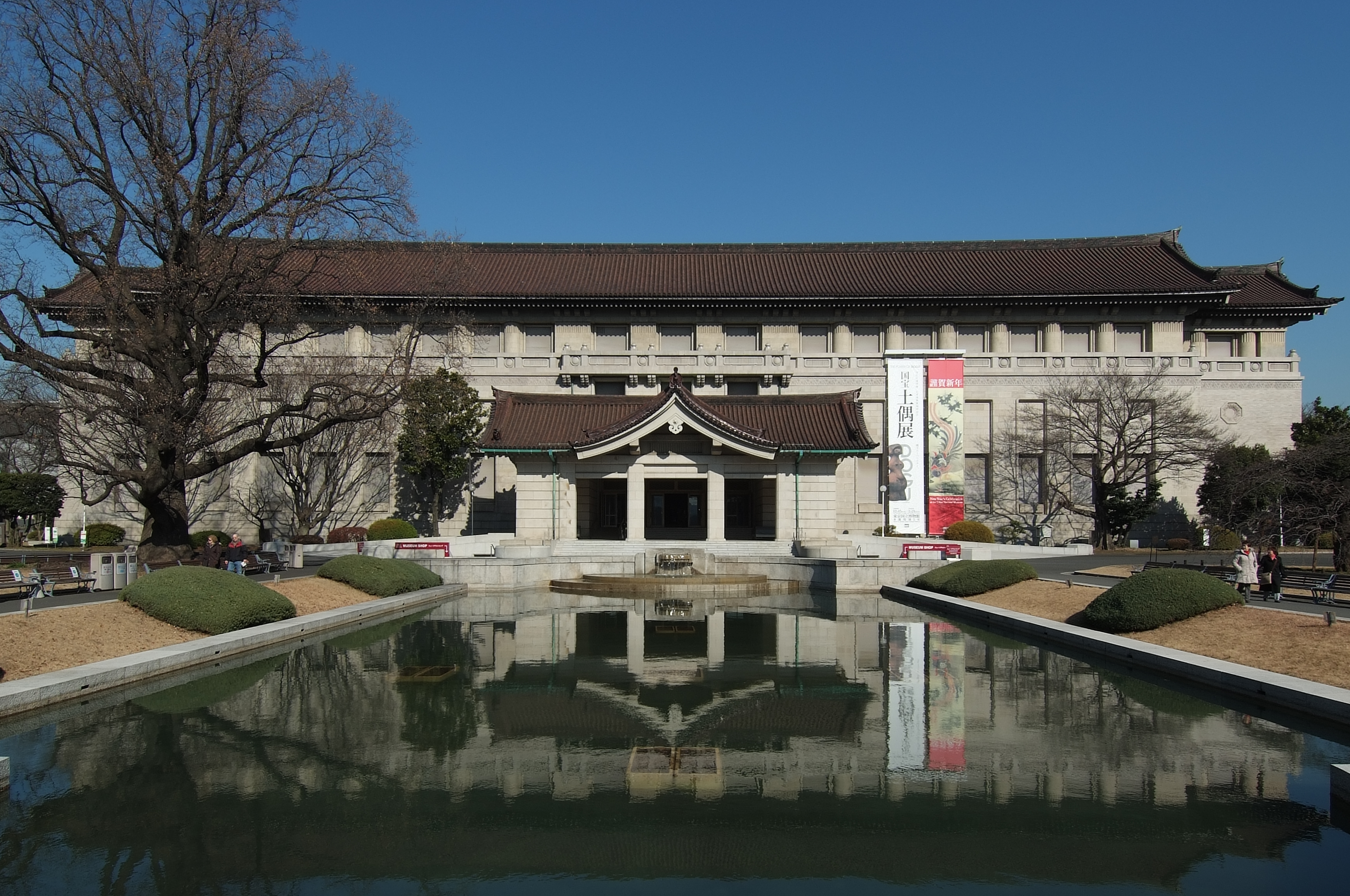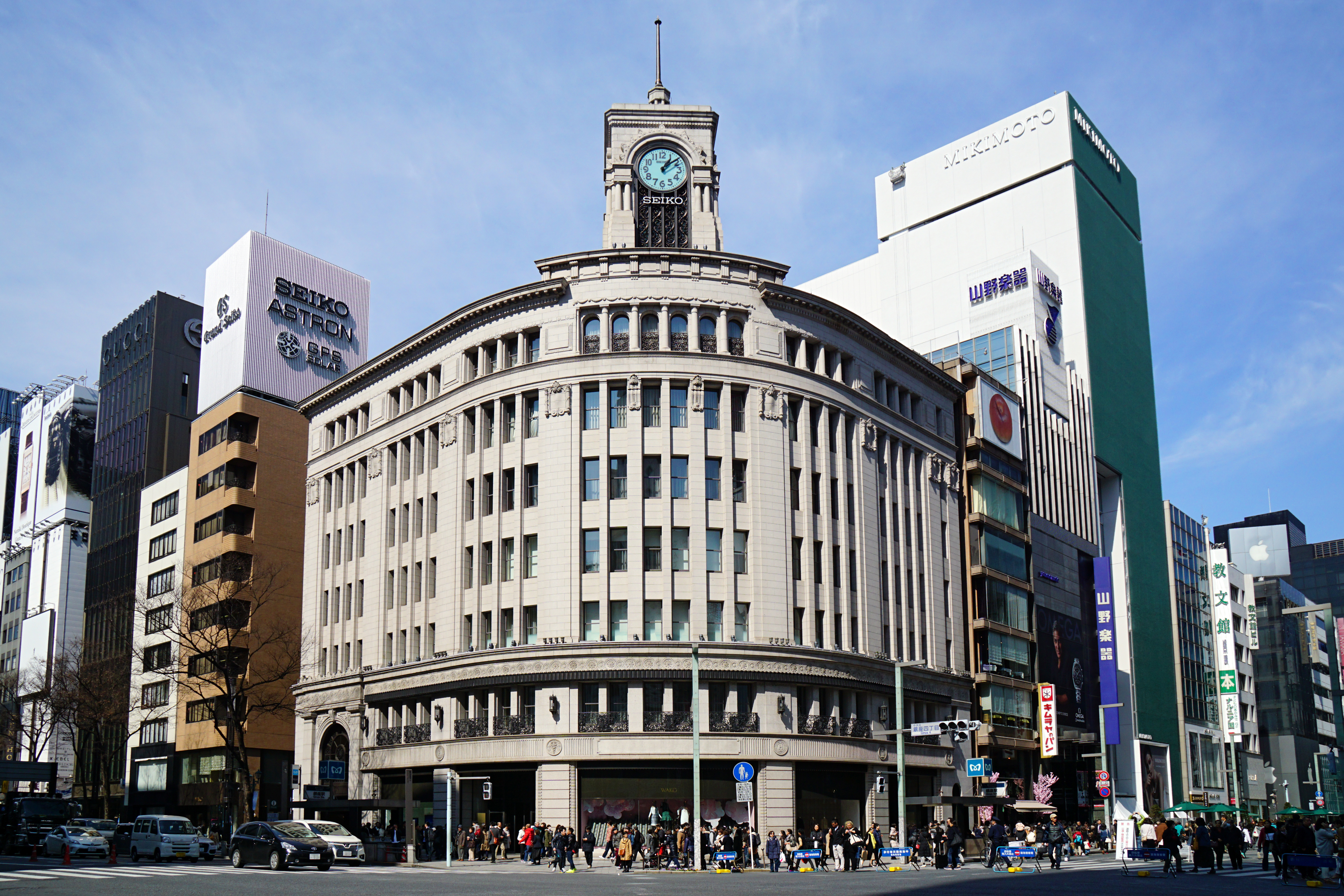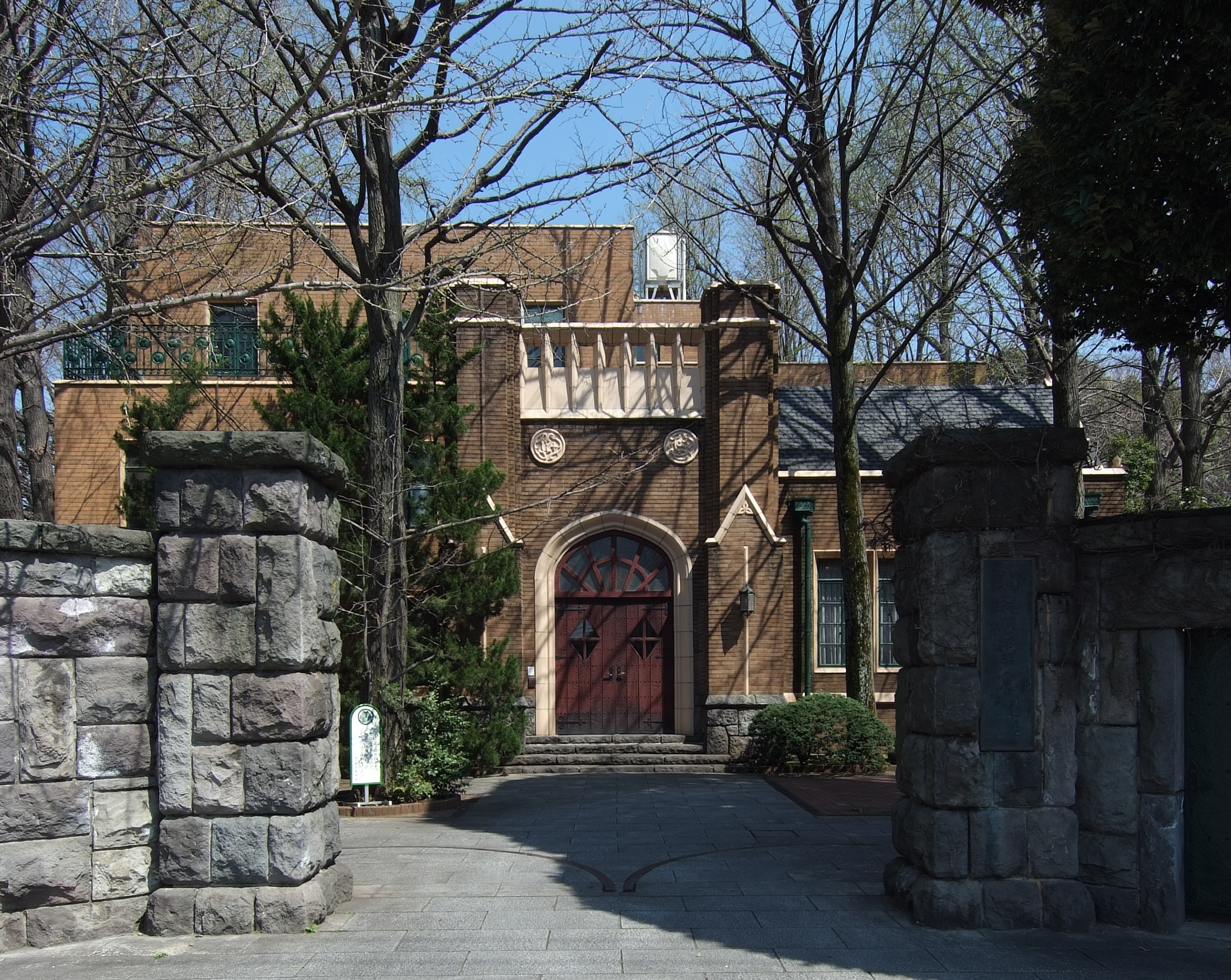Jin Watanabe (architect) on:
[Wikipedia]
[Google]
[Amazon]
, also known as Hitoshi Watanabe, was a Japanese architect responsible for many buildings in the inter-war years.




 * Takanawa Telephone Station (1918) Minato-ku, Tokyo. Tetsushin Ministry of Construction Division office building (demolished).
* Nihonbashi Telephone Office (1919) Chuo-ku, Tokyo. Tetsushin Ministry of Construction Division office building (demolished).
* Fuel Research Institute (1921) Kawaguchi City, Saitama Prefecture (demolished).
* Hotel New Grand (1927) Yokohama-city kanagawa prefecture.
* Dragon Corner Scattered Main Office (1923)
* Electric Club (1927)
* Odawara Express Railway Headquarters (1927) Shibuya-ku, Tokyo. Adjacent to Minami-Shinjuku Station . Expressionist style architecture. Odakyu Electric Railway moved its head office to Odakyu Meiji Yasuda Life Building in the west exit of Shinjuku Station in 1975, so it is now Odakyu Minami Shinjuku Building.
* Shinjuku Ward Waseda Elementary School (1928) Shinjuku-ku, Tokyo. Tokyo City was at the time of completion.
* Ando House (1928) Chiyoda ward, Tokyo. Constructed as a home of a founding company of a construction company, and is currently undergoing renovation, it remains in Tokyo's Nishikicho as an annex to the Miyauchi province.
* Tokugawa Yoshika's House (now Yatsugatake Kogen Hutte, 1928)
* Hattori Clock Shop (1932) Chuo-ku, Tokyo. Neo-renaissance style. Currently, the head office of Wako Co., Ltd., but still the registered head office of Seiko Holdings Inc.
* Tokugawa Reimei Headquarters Building (1932) Mejiro in Toshima Ward, Tokyo.
* Japanese theater (1933) Chiyoda ward, Tokyo. Expressionist style architecture (demolished). Yurakucho Marion is built in the ruins .
* Norin Chuo Bank Yurakucho Building (1933) Chiyoda ward, Tokyo. Historicist style architecture with Ionian style colonnade (demolished). Image reproduction on the wall of DN tower 21. The site is the new building (high rise building) of DN Tower 21.
* Tokyo Imperial Museum planning plan, Taito-Ku, Tokyo. Current Tokyo National Museum Main Building. Competition winning plan. The implementation design is Miyauchi Interior Takumi Dormitory (completed in 1937) and Watanabe was not involved in the implementation design. Generally classified as a masterpiece of the Imperial Crown style (there are also architectural historians who cast doubt on the classification, such as Fujinobu Terunobu).
* Toyoko Department Store (1934) Shibuya-ku, Tokyo. Later Tokyu Department Store Toyoko Store East Building. It was demolished in 2013.
* Hinata Atami Bettei (1934) Atami City, Shizuoka Prefecture. Japanese-style architecture with two floors. Basement part (1936) which B. Taut designed interior for is important cultural property of country. Watanabe-designed Japanese-style architecture (seater) is designated as an important cultural property.
* Osaka Broadcasting Hall (1936) Baba-cho, Chuo-ku, Osaka City, Osaka Prefecture. Winner in nominated design competition. Demolished in 2002.
* Tenmaya Okayama store (1936) Kita Ward, Okayama City, Okayama Prefecture.
* Ishizaka Taizo House (1937) Shibuya-ku, Tokyo. The residence of Taizo Ishizaka, then Managing Director of Dai-ichi Life, and later chairman of the Keidanren, is now used as a Bulgarian ambassador's residence.
* Dai-ichi Seiyakukan (1938) Chiyoda ward, Tokyo. Former Dai-ichi Life Insurance Mutual Company Main Building. Joint design with Yosaku Matsumoto. It is famous for the headquarters of the GHQ being set up after the Pacific War in Japan during the Japanese Occupation . It was also partially preserved and redeveloped together with the Norin Chuo Kenko Yurakucho building designed by Watanabe. The west side part is used as a main building of the DN tower 21 with a part of the frame left.
* Hara House (1938) Shinagawa Ward, Tokyo. The current Hara Museum of Art. Watanabe's work adopts a rare early modernism style.
* Fukuya Hacchobori Main Store (Hiroshima) (1938). Hiroshima, Hiroshima Prefecture. Interior destroyed in atomic bombing, but the shell remains and is in use, retaining much of its original appearance.
* Takanawa Telephone Station (1918) Minato-ku, Tokyo. Tetsushin Ministry of Construction Division office building (demolished).
* Nihonbashi Telephone Office (1919) Chuo-ku, Tokyo. Tetsushin Ministry of Construction Division office building (demolished).
* Fuel Research Institute (1921) Kawaguchi City, Saitama Prefecture (demolished).
* Hotel New Grand (1927) Yokohama-city kanagawa prefecture.
* Dragon Corner Scattered Main Office (1923)
* Electric Club (1927)
* Odawara Express Railway Headquarters (1927) Shibuya-ku, Tokyo. Adjacent to Minami-Shinjuku Station . Expressionist style architecture. Odakyu Electric Railway moved its head office to Odakyu Meiji Yasuda Life Building in the west exit of Shinjuku Station in 1975, so it is now Odakyu Minami Shinjuku Building.
* Shinjuku Ward Waseda Elementary School (1928) Shinjuku-ku, Tokyo. Tokyo City was at the time of completion.
* Ando House (1928) Chiyoda ward, Tokyo. Constructed as a home of a founding company of a construction company, and is currently undergoing renovation, it remains in Tokyo's Nishikicho as an annex to the Miyauchi province.
* Tokugawa Yoshika's House (now Yatsugatake Kogen Hutte, 1928)
* Hattori Clock Shop (1932) Chuo-ku, Tokyo. Neo-renaissance style. Currently, the head office of Wako Co., Ltd., but still the registered head office of Seiko Holdings Inc.
* Tokugawa Reimei Headquarters Building (1932) Mejiro in Toshima Ward, Tokyo.
* Japanese theater (1933) Chiyoda ward, Tokyo. Expressionist style architecture (demolished). Yurakucho Marion is built in the ruins .
* Norin Chuo Bank Yurakucho Building (1933) Chiyoda ward, Tokyo. Historicist style architecture with Ionian style colonnade (demolished). Image reproduction on the wall of DN tower 21. The site is the new building (high rise building) of DN Tower 21.
* Tokyo Imperial Museum planning plan, Taito-Ku, Tokyo. Current Tokyo National Museum Main Building. Competition winning plan. The implementation design is Miyauchi Interior Takumi Dormitory (completed in 1937) and Watanabe was not involved in the implementation design. Generally classified as a masterpiece of the Imperial Crown style (there are also architectural historians who cast doubt on the classification, such as Fujinobu Terunobu).
* Toyoko Department Store (1934) Shibuya-ku, Tokyo. Later Tokyu Department Store Toyoko Store East Building. It was demolished in 2013.
* Hinata Atami Bettei (1934) Atami City, Shizuoka Prefecture. Japanese-style architecture with two floors. Basement part (1936) which B. Taut designed interior for is important cultural property of country. Watanabe-designed Japanese-style architecture (seater) is designated as an important cultural property.
* Osaka Broadcasting Hall (1936) Baba-cho, Chuo-ku, Osaka City, Osaka Prefecture. Winner in nominated design competition. Demolished in 2002.
* Tenmaya Okayama store (1936) Kita Ward, Okayama City, Okayama Prefecture.
* Ishizaka Taizo House (1937) Shibuya-ku, Tokyo. The residence of Taizo Ishizaka, then Managing Director of Dai-ichi Life, and later chairman of the Keidanren, is now used as a Bulgarian ambassador's residence.
* Dai-ichi Seiyakukan (1938) Chiyoda ward, Tokyo. Former Dai-ichi Life Insurance Mutual Company Main Building. Joint design with Yosaku Matsumoto. It is famous for the headquarters of the GHQ being set up after the Pacific War in Japan during the Japanese Occupation . It was also partially preserved and redeveloped together with the Norin Chuo Kenko Yurakucho building designed by Watanabe. The west side part is used as a main building of the DN tower 21 with a part of the frame left.
* Hara House (1938) Shinagawa Ward, Tokyo. The current Hara Museum of Art. Watanabe's work adopts a rare early modernism style.
* Fukuya Hacchobori Main Store (Hiroshima) (1938). Hiroshima, Hiroshima Prefecture. Interior destroyed in atomic bombing, but the shell remains and is in use, retaining much of its original appearance.
INAX Report Number 183
featuring Watanabe's work (in Japanese) {{DEFAULTSORT:Watanabe, Jin 1887 births 1973 deaths Expressionist architects Imperial Crown Style architecture Japanese architects Modernist architects
Biography
Jin Watanabe was born on February 16, 1887, in Sado,Niigata Prefecture
is a Prefectures of Japan, prefecture in the Chūbu region of Honshu of Japan. Niigata Prefecture has a population of 2,227,496 (1 July 2019) and is the List of Japanese prefectures by area, fifth-largest prefecture of Japan by geographic area ...
, Japan, and grew up in Tokyo. His father was Wataru Watanabe (渡辺渡), who became director of the Tokyo Imperial University Institute of Technology. In July 1912, Watanabe graduated from Tokyo Imperial University's Institute of Technology, and after graduation served at the Railroad Institute. In 1926, he visited Europe and the United States for architectural research.
Name
His given name (the character 仁) can be read as either ''Jin'' or ''Hitoshi''.Works
Watanabe is known in particular for designing the Imperial Household Museum (1931-1938), the Hattori Clock shop and the Daiichi Seimei Insurance Building (c. 1938, in collaboration with architect Yosaku Matsumoto) in Tokyo. In 1931, a competition was held to replace the original Imperial Household Museum building. This had been designed by Josiah Conder, and completed in 1882. However, it was destroyed by an earthquake in 1923. Watanabe won the competition with a design that followed the lineage of Imperial Crown Style, having a neo-classical base topped with tiled and gabled Japanese-style roofs. Although constructed from reinforced concrete, some elements of the building alluded to traditional Japanese timber construction techniques. It is today known as the ''Honkan'' building at theTokyo National Museum
The or TNM is an art museum in Ueno Park in the Taitō ward of Tokyo, Japan. It is one of the four museums operated by the National Institutes for Cultural Heritage ( :ja:国立文化財機構), is considered the oldest national museum in Japan, ...
.
The Dai-ichi Seimei building is located across the street from the main entrance to the Imperial Palace grounds in the Marunouchi area of Tokyo. It was chosen by General Douglas MacArthur
Douglas MacArthur (26 January 18805 April 1964) was an American military leader who served as General of the Army for the United States, as well as a field marshal to the Philippine Army. He had served with distinction in World War I, was C ...
as the site for Allied Headquarters from 1945-1952.
Selected works



 * Takanawa Telephone Station (1918) Minato-ku, Tokyo. Tetsushin Ministry of Construction Division office building (demolished).
* Nihonbashi Telephone Office (1919) Chuo-ku, Tokyo. Tetsushin Ministry of Construction Division office building (demolished).
* Fuel Research Institute (1921) Kawaguchi City, Saitama Prefecture (demolished).
* Hotel New Grand (1927) Yokohama-city kanagawa prefecture.
* Dragon Corner Scattered Main Office (1923)
* Electric Club (1927)
* Odawara Express Railway Headquarters (1927) Shibuya-ku, Tokyo. Adjacent to Minami-Shinjuku Station . Expressionist style architecture. Odakyu Electric Railway moved its head office to Odakyu Meiji Yasuda Life Building in the west exit of Shinjuku Station in 1975, so it is now Odakyu Minami Shinjuku Building.
* Shinjuku Ward Waseda Elementary School (1928) Shinjuku-ku, Tokyo. Tokyo City was at the time of completion.
* Ando House (1928) Chiyoda ward, Tokyo. Constructed as a home of a founding company of a construction company, and is currently undergoing renovation, it remains in Tokyo's Nishikicho as an annex to the Miyauchi province.
* Tokugawa Yoshika's House (now Yatsugatake Kogen Hutte, 1928)
* Hattori Clock Shop (1932) Chuo-ku, Tokyo. Neo-renaissance style. Currently, the head office of Wako Co., Ltd., but still the registered head office of Seiko Holdings Inc.
* Tokugawa Reimei Headquarters Building (1932) Mejiro in Toshima Ward, Tokyo.
* Japanese theater (1933) Chiyoda ward, Tokyo. Expressionist style architecture (demolished). Yurakucho Marion is built in the ruins .
* Norin Chuo Bank Yurakucho Building (1933) Chiyoda ward, Tokyo. Historicist style architecture with Ionian style colonnade (demolished). Image reproduction on the wall of DN tower 21. The site is the new building (high rise building) of DN Tower 21.
* Tokyo Imperial Museum planning plan, Taito-Ku, Tokyo. Current Tokyo National Museum Main Building. Competition winning plan. The implementation design is Miyauchi Interior Takumi Dormitory (completed in 1937) and Watanabe was not involved in the implementation design. Generally classified as a masterpiece of the Imperial Crown style (there are also architectural historians who cast doubt on the classification, such as Fujinobu Terunobu).
* Toyoko Department Store (1934) Shibuya-ku, Tokyo. Later Tokyu Department Store Toyoko Store East Building. It was demolished in 2013.
* Hinata Atami Bettei (1934) Atami City, Shizuoka Prefecture. Japanese-style architecture with two floors. Basement part (1936) which B. Taut designed interior for is important cultural property of country. Watanabe-designed Japanese-style architecture (seater) is designated as an important cultural property.
* Osaka Broadcasting Hall (1936) Baba-cho, Chuo-ku, Osaka City, Osaka Prefecture. Winner in nominated design competition. Demolished in 2002.
* Tenmaya Okayama store (1936) Kita Ward, Okayama City, Okayama Prefecture.
* Ishizaka Taizo House (1937) Shibuya-ku, Tokyo. The residence of Taizo Ishizaka, then Managing Director of Dai-ichi Life, and later chairman of the Keidanren, is now used as a Bulgarian ambassador's residence.
* Dai-ichi Seiyakukan (1938) Chiyoda ward, Tokyo. Former Dai-ichi Life Insurance Mutual Company Main Building. Joint design with Yosaku Matsumoto. It is famous for the headquarters of the GHQ being set up after the Pacific War in Japan during the Japanese Occupation . It was also partially preserved and redeveloped together with the Norin Chuo Kenko Yurakucho building designed by Watanabe. The west side part is used as a main building of the DN tower 21 with a part of the frame left.
* Hara House (1938) Shinagawa Ward, Tokyo. The current Hara Museum of Art. Watanabe's work adopts a rare early modernism style.
* Fukuya Hacchobori Main Store (Hiroshima) (1938). Hiroshima, Hiroshima Prefecture. Interior destroyed in atomic bombing, but the shell remains and is in use, retaining much of its original appearance.
* Takanawa Telephone Station (1918) Minato-ku, Tokyo. Tetsushin Ministry of Construction Division office building (demolished).
* Nihonbashi Telephone Office (1919) Chuo-ku, Tokyo. Tetsushin Ministry of Construction Division office building (demolished).
* Fuel Research Institute (1921) Kawaguchi City, Saitama Prefecture (demolished).
* Hotel New Grand (1927) Yokohama-city kanagawa prefecture.
* Dragon Corner Scattered Main Office (1923)
* Electric Club (1927)
* Odawara Express Railway Headquarters (1927) Shibuya-ku, Tokyo. Adjacent to Minami-Shinjuku Station . Expressionist style architecture. Odakyu Electric Railway moved its head office to Odakyu Meiji Yasuda Life Building in the west exit of Shinjuku Station in 1975, so it is now Odakyu Minami Shinjuku Building.
* Shinjuku Ward Waseda Elementary School (1928) Shinjuku-ku, Tokyo. Tokyo City was at the time of completion.
* Ando House (1928) Chiyoda ward, Tokyo. Constructed as a home of a founding company of a construction company, and is currently undergoing renovation, it remains in Tokyo's Nishikicho as an annex to the Miyauchi province.
* Tokugawa Yoshika's House (now Yatsugatake Kogen Hutte, 1928)
* Hattori Clock Shop (1932) Chuo-ku, Tokyo. Neo-renaissance style. Currently, the head office of Wako Co., Ltd., but still the registered head office of Seiko Holdings Inc.
* Tokugawa Reimei Headquarters Building (1932) Mejiro in Toshima Ward, Tokyo.
* Japanese theater (1933) Chiyoda ward, Tokyo. Expressionist style architecture (demolished). Yurakucho Marion is built in the ruins .
* Norin Chuo Bank Yurakucho Building (1933) Chiyoda ward, Tokyo. Historicist style architecture with Ionian style colonnade (demolished). Image reproduction on the wall of DN tower 21. The site is the new building (high rise building) of DN Tower 21.
* Tokyo Imperial Museum planning plan, Taito-Ku, Tokyo. Current Tokyo National Museum Main Building. Competition winning plan. The implementation design is Miyauchi Interior Takumi Dormitory (completed in 1937) and Watanabe was not involved in the implementation design. Generally classified as a masterpiece of the Imperial Crown style (there are also architectural historians who cast doubt on the classification, such as Fujinobu Terunobu).
* Toyoko Department Store (1934) Shibuya-ku, Tokyo. Later Tokyu Department Store Toyoko Store East Building. It was demolished in 2013.
* Hinata Atami Bettei (1934) Atami City, Shizuoka Prefecture. Japanese-style architecture with two floors. Basement part (1936) which B. Taut designed interior for is important cultural property of country. Watanabe-designed Japanese-style architecture (seater) is designated as an important cultural property.
* Osaka Broadcasting Hall (1936) Baba-cho, Chuo-ku, Osaka City, Osaka Prefecture. Winner in nominated design competition. Demolished in 2002.
* Tenmaya Okayama store (1936) Kita Ward, Okayama City, Okayama Prefecture.
* Ishizaka Taizo House (1937) Shibuya-ku, Tokyo. The residence of Taizo Ishizaka, then Managing Director of Dai-ichi Life, and later chairman of the Keidanren, is now used as a Bulgarian ambassador's residence.
* Dai-ichi Seiyakukan (1938) Chiyoda ward, Tokyo. Former Dai-ichi Life Insurance Mutual Company Main Building. Joint design with Yosaku Matsumoto. It is famous for the headquarters of the GHQ being set up after the Pacific War in Japan during the Japanese Occupation . It was also partially preserved and redeveloped together with the Norin Chuo Kenko Yurakucho building designed by Watanabe. The west side part is used as a main building of the DN tower 21 with a part of the frame left.
* Hara House (1938) Shinagawa Ward, Tokyo. The current Hara Museum of Art. Watanabe's work adopts a rare early modernism style.
* Fukuya Hacchobori Main Store (Hiroshima) (1938). Hiroshima, Hiroshima Prefecture. Interior destroyed in atomic bombing, but the shell remains and is in use, retaining much of its original appearance.
References
Citations
Works cited
* *External links
INAX Report Number 183
featuring Watanabe's work (in Japanese) {{DEFAULTSORT:Watanabe, Jin 1887 births 1973 deaths Expressionist architects Imperial Crown Style architecture Japanese architects Modernist architects